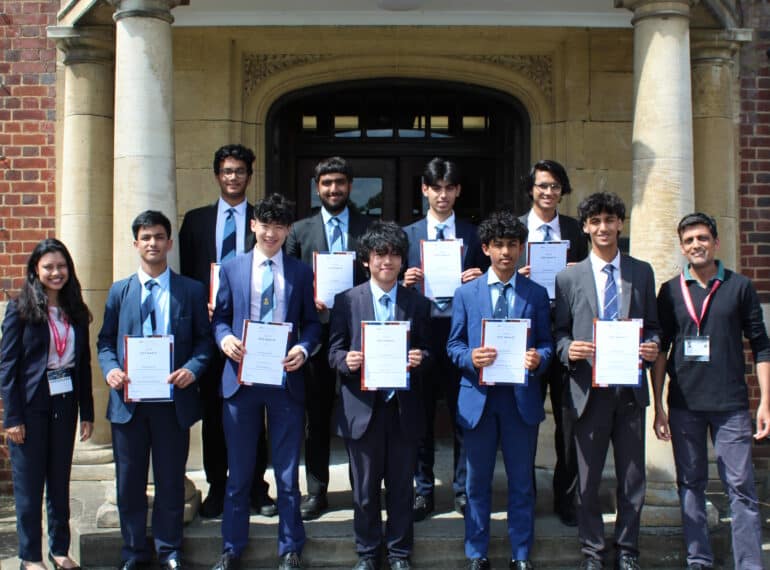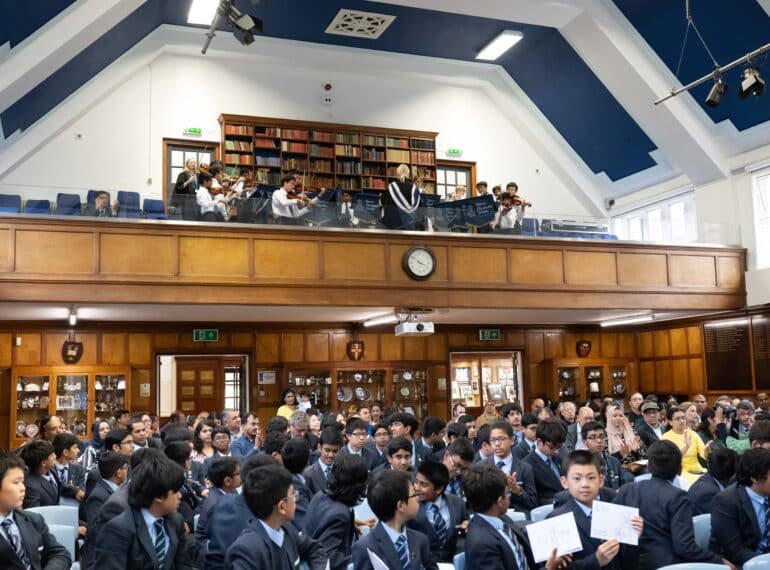
Queen Elizabeth’s School commemorated Elizabethans who gave their lives in conflicts in traditional fashion, while pupils and staff deepened their knowledge of QE’s wartime history through a special Remembrance quiz.
The QE Combined Cadet Force took their places in the Remembrance Sunday parade and service in High Barnet, and then also played a leading role in the Armistice Day event at the School yesterday.
Headmaster Neil Enright said: “The Armistice Day ceremony here is an important opportunity for today’s young Elizabethans to honour forebears who made the ultimate sacrifice in the two world wars and other conflicts. This year’s quiz creatively reinforced that aim by teaching pupils interesting facts about what war meant, both generally and for QE Barnet in particular.
“I am, of course, very grateful to the members of our CCF who represented the School so effectively in the civic Remembrance Sunday parade.”
The CCF set off from – and returned to – 240 (Barnet) Transport Squadron RLC on St Albans Road. The service took place at St John the Baptist Church and at the Chipping Barnet war memorial outside the parish church.
The ceremony at QE took place as in previous years in the ‘Crush Hall’ in the Main Building at 11am. The poem, In Flanders Fields, was read, the Last Post played, and wreaths were laid at the School’s war memorial. A two-minute silence was observed across the School.
The Remembrance Day quiz, compiled by Enrichment tutor and Mathematics teacher Nadeem Kydd, was made available to form groups over the past few days. Many staff participated.
Form tutors were encouraged to use the 17-question, multiple-choice quiz as a springboard for discussions about the significance of the Armistice Day events and QE’s history during the world wars.
Here are some of the questions. (Answers are at the bottom).
- During World War I, QE pupils who won prizes were given money. But what did most choose to do with their money?
- Where were soldiers’ horses kept during World War I?
- In 1637, plans to unite QE with which school were shelved because of increasing political uncertainty in the run-up to the English Civil War?
- Why were loudspeakers at Founder’s Day originally installed?
- A memorial to Commonwealth soldiers, including those from the Indian sub-continent, Africa, Nepal, and the Caribbean, can be found where in London?
Answers
- Donate it to refugees
- The School playground
- Merchant Taylors’
- To warn of bombing raids
- Constitution Hill
Click on the thumbnails to view the images.


 In a special Lower School assembly lecture, he spoke of how he overcame his initial despair and, with the help of his wife, used the news as a springboard into what became the happiest period of his life. He is now a philanthropist, an advocate for several charities and a fundraising athlete.
In a special Lower School assembly lecture, he spoke of how he overcame his initial despair and, with the help of his wife, used the news as a springboard into what became the happiest period of his life. He is now a philanthropist, an advocate for several charities and a fundraising athlete. Since his diagnosis he has completed numerous endurance events, including marathons, cycling challenges, triathlons and a 30 sports in 30 days feat – all to raise funds for Parkinson’s research. He even set Guinness World Records for the longest three-legged distances covered in 12 and 24 hours.
Since his diagnosis he has completed numerous endurance events, including marathons, cycling challenges, triathlons and a 30 sports in 30 days feat – all to raise funds for Parkinson’s research. He even set Guinness World Records for the longest three-legged distances covered in 12 and 24 hours.



 They timed their visits to coincide with School Diversity Week, which QE was celebrating in partnership with LGBT+ young people’s charity, Just Like Us.
They timed their visits to coincide with School Diversity Week, which QE was celebrating in partnership with LGBT+ young people’s charity, Just Like Us. Also in the presentation a written explanation of the terms represented by the initials LGBTQIA+, while the same slide showed the flags associated with the movement, including, for example, flags for ‘Agender’, ‘Asexual’ and ‘Genderqueer’, as well as the Pride flag itself.
Also in the presentation a written explanation of the terms represented by the initials LGBTQIA+, while the same slide showed the flags associated with the movement, including, for example, flags for ‘Agender’, ‘Asexual’ and ‘Genderqueer’, as well as the Pride flag itself. The presentation also featured Akshay Shah’s winning entry in a Pride-themed computer desktop design competition. Akshay, whose colourful design is pictured, said: “Each strand represents a different gender/sexuality. They are made up of organic swirly shapes, which represents the flexible nature of Pride.” Akshay, of Year 9, depicted not only the colours of the Pride flag but also, on the white strands, “lesser-known genders/sexualities” including gynesexual, homoromantic, demiromantic, genderflux and skoliosexual.
The presentation also featured Akshay Shah’s winning entry in a Pride-themed computer desktop design competition. Akshay, whose colourful design is pictured, said: “Each strand represents a different gender/sexuality. They are made up of organic swirly shapes, which represents the flexible nature of Pride.” Akshay, of Year 9, depicted not only the colours of the Pride flag but also, on the white strands, “lesser-known genders/sexualities” including gynesexual, homoromantic, demiromantic, genderflux and skoliosexual.